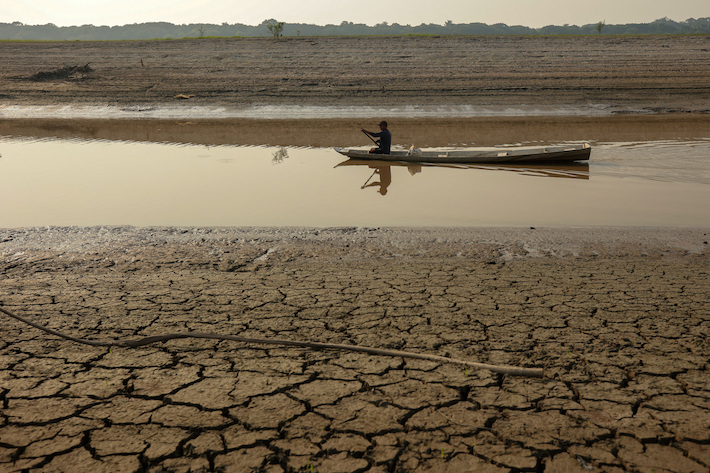Pakistan and India have been hit by huge sudden downpours of rain known locally as cloudbursts in recent days, killing hundreds of people in the flash floods and landslides they triggered.
China has also been rocked by a wave of monsoon season floods with over 300 rivers exceeding warning levels this year, with some reaching record highs.
In the month from July 16 to August 15, some 330 rivers exceeded warning levels, with 77 surpassing safety thresholds and 22 at record levels, according to Xinhua state news agency.
ALSO SEE: SoftBank, Intel ‘Had Talks on Chip Unit Before $2bn Stock Deal’

Short intense cloudbursts
In South Asia, a ‘cloudburst’ is a widely accepted definition that means more than 100 mm (4 inches) of rain fell in one hour, over a small area.
This year, the monsoon, which originates in the Bay of Bengal and then sweeps westwards across northern India to Pakistan every summer, has brought deadly cloudbursts.
Weather studies say cloudbursts typically occur in South Asia when warm, monsoon winds, laden with moisture, meet the cold mountain air in the north of India and Pakistan, causing condensation. With a warming planet, the monsoon has hotter air, which can carry more moisture.
India’s weather department data shows cloudbursts are most common in the Himalayan regions of Indian Kashmir, Ladakh, Himachal Pradesh and Uttarakhand.
Fahad Saeed, a senior climate scientist at Berlin-based Climate Analytics, said that in the mountains of northern Pakistan, the warm monsoon system coming from the east was meeting colder air coming from the west, from the subtropical jet stream – a high-altitude weather system that originates in the Mediterranean.
Global warming is pushing this jet stream further south in summer, he said, where it can now combine with the lower-level clouds of the monsoon in Pakistan, forming a tower of clouds which then generates intense rain.
Similar intense rainfall, though triggered by different local factors, takes place around the world, such as the floods in Texas in early July when more than 300 mm of rain fell in less than an hour, sending a wall of water down the Guadalupe River.
Disasters in Indian, Pakistani uplands
In South Asia, the current monsoon season has so far seen at least four major deadly cloudbursts, including in Uttarakhand, India, where a video captured the moment when village buildings were swept down a mountain.
And over 314 people have been killed since Friday in Buner, in the Hindu Kush mountain range in northwest Pakistan, including more than 200 people shortly after 150mm of rain fell within an hour.
SD Sanap, a scientist with the India Meteorological Department’s Pune office, said such cloudburst events were becoming more frequent in the western Himalayas, which run across India and into Pakistan, but pinning the rise on a single cause was not easy.
The cloudburst events on both sides of the border were triggered the same way: very moist monsoon air, upslope winds, and storms that stalled over valleys, Moetasim Ashfaq, a weather expert based in the US, said.
If a cloudburst happens over flat land, the rainfall spreads over a wide area, so the impact is less severe, said Pradeep Dangol, a senior hydrology research associate at the International Centre for Integrated Mountain Development, based in Nepal.
But in steep mountain valleys, the rain is concentrated into narrow streams and slopes, with the potential to trigger flash floods and landslides, he said.
Only short-term warnings possible
Forecasting such events days in advance is nearly impossible, though radars can track the build-up of dense cloud formations and give short-term warnings of intense downpours, Sanap said.
To strengthen monitoring, the India Meteorological Department has installed new radars across the Himalayas and set up observatories aimed at improving early warnings and understanding of these extreme weather events.
Syed Muhammad Tayyab Shah, who leads risk assessment at Pakistan’s National Disaster Management Authority, part of the government, said that it was possible to warn about the general area, but not possible to pinpoint the exact location in advance where a cloudburst will happen.
Flood season not over, China says
Meanwhile, China also experienced scattered and concurrent extreme rainfall events that posed serious disaster risks, its Ministry of Water Resources said on Monday.
Three typhoons hit 13 provincial regions on the Chinese mainland in a critical flood control period from mid-July to mid-August, when several hundred rivers rose to peak levels, a report by Xinhua said.
Over three dozen emergency teams were sent to affected areas to guide local officials’ handling of flood and rainfall crises.
The ministry warned that there was still the potential for further extreme weather events as the main flood season has yet to end.
In a speech on Friday Prime Minister Li Qiang urged citizens to accelerate green and low-carbon development and “follow the path of ecological priority.”
Meanwhile, local officials continue to encourage owners of new energy vehicles (NEVs) to power their cars at charging stations linked to renewable power sources.
- Reuters with additional input and editing by Jim Pollard
ALSO SEE:
Floods Swamp Cities in Southwest China, And More Storms Due
Firms Underestimating Risks From Carbon-Fuelled Climate Change
Carbon Removals Not Growing Fast Enough For Climate Goals
Climate Change Has Cost China $32 Billion in Just One Quarter
Floods or Drought: Climate Change Worsens Global Water Woes
China’s Billion-Ton Coal Expansion Plan Sparks Methane Fears
LNG’s Carbon Footprint 33% Bigger Than Coal’s – CC
Forest Fires a Double Whammy for Climate Change Fight – Guardian
Continued Fossil Fuel Investments Put $557 Trillion ‘At Risk’
Scientists Fear Nature’s Carbon Sinks Are Failing – Guardian
























